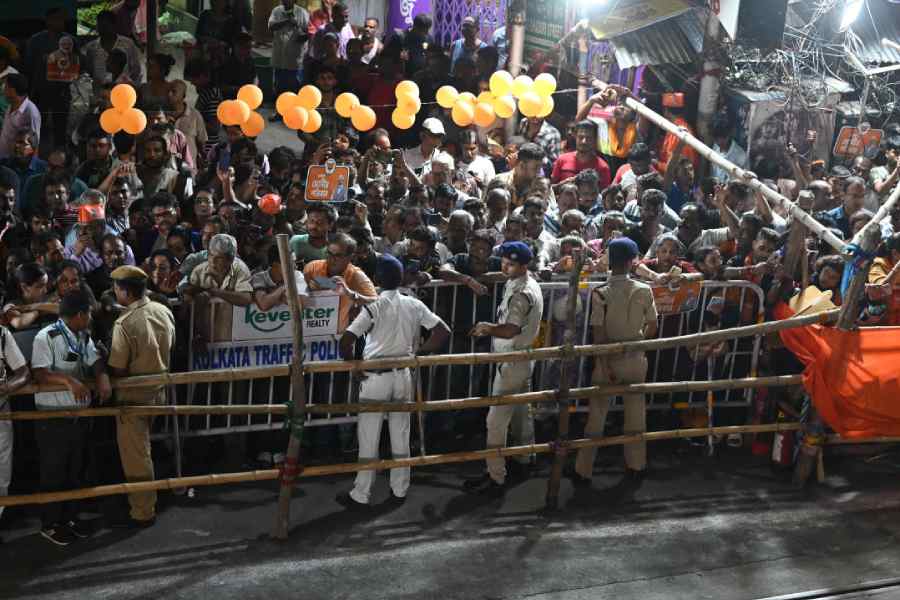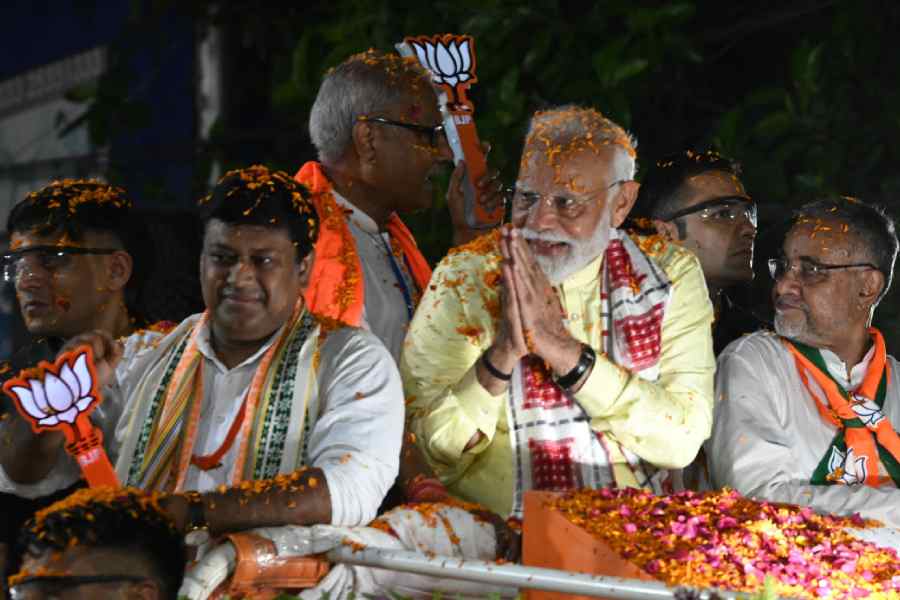Prime Minister Narendra Modi's demeanour and his chosen road show route in north Calcutta on Tuesday evening made it apparent that the BJP is keen to rid itself of the bohiragawto (outsider) label that has been its Achilles heel in Bengal.
Modi paid tributes to three Bengali icons and took part in a road show along Bidhan Sarani between Shyambazar and Hedua, that stretch of the two-century-old north-south axial thoroughfare known for representing various facets of Bengal’s culture, clothing and cuisine.
The Prime Minister’s packed schedule was planned for an area deemed the nucleus of north Calcutta before the last phase of polls on Saturday when nine seats in and around the city that are seen as Trinamool Congress bastions go to vote.
Modi — accompanied by state BJP chief Sukanta Majumdar, leader of the Opposition in the Assembly Suvendu Adhikari, Kolkata Uttar candidate Tapas Roy and Dum Dum nominee Silbhadra Datta — did not utter a word in public during the 100-odd minutes he spent in north Calcutta, but his evening outing was all about messaging.

The crowd at Bidhan Sarani waits to catch a glimpse of the Prime Minister Bishwarup Dutta
As the cavalcade passed by some of the most important stopovers in what was once considered the entertainment and performing arts hub of the city — such as the Star Theatre and the octet of cinema halls (Sree, Uttara, Radha, Rupbani, Bina, Minar, Mitra and Darpana, of which only Minar survives) — the Prime Minister attempted to tug at more Bengali hearts than in his rallies earlier in the day, said 64-year-old Ashim Kumar Banerjee from Hatibagan’s Hari Ghosh Street, a shout away from one of the city’s foremost street-shopping districts.
“You saw Modiji’s road show and the kind of response he got from the people of north Calcutta…. The TMC cannot call us outsiders any more,” said a BJP member, underscoring the importance of the theme of the event — Bangalir Hridoye Modi (Modi in the hearts of Bengalis) — to the performance of the party in the state.
“This stretch, instead of any other part of the city, was chosen after a lot of deliberation,” he added.
While the BJP’s evening show in north Calcutta, for which busloads of people were brought from adjoining districts, bore all the signs of a successful political outing, a Trinamool spokesperson warned against mistaking one swallow for a summer.
“This drama won’t work. We will win all the nine seats in the June 1 phase and repeat our 2019 performance,” said Trinamool’s Kunal Ghosh.
Although the BJP emerged as the main Opposition party in Bengal by bagging 18 seats and 40.7 per cent of the votes in the 2019 Lok Sabha polls and grabbed the entire Opposition space in the 2021 Assembly elections, the party has been finding it difficult to contest the TMC narrative spun around the bohiragawto leitmotif.

Narendra Modi during a road show in Calcutta on Tuesday evening. Picture by Bishwarup Dutta
A number of mistakes — both voluntary and inadvertent — by the BJP leadership endorsed this hypothesis time and time again.
For instance, the BJP’s IT cell made the blunder of attributing to party national president J.P. Nadda on December 9, 2020, a quote that Rabindranath Tagore had been born in Visva-Bharati.
Amit Shah’s April 14, 2019, road show through north Calcutta dealt a body blow to the BJP as it was followed by the vandalism of Ishwarchandra Vidyasagar’s bust. In the final phase of the 2019 general election days later, the BJP won none of the nine seats, despite bagging 18 of the 33 prior to that.
This newspaper asked several BJP leaders whether Modi’s 1.8km outing on Tuesday was aimed at undoing such gaffes, but none wanted to handle the question on record.
“Yes, there have been some mistakes in the past.... But nobody will talk about them after today’s show as we had planned his schedule keeping in mind the tastes and preferences of the Bengali common folk,” said a source in the BJP.
The launch of the Calcutta programmes — with Modi’s visit to Mayer Bari in Baghbazar around 6.45pm — could not have been better, given the connection of countless Hindu Bengalis with Sarada Devi and Ramakrishna Paramahansa, he added.
The next stop — the Netaji Subhas Chandra Bose statue at the Shyambazar Five-point Crossing, from where the road show rolled out around 7.10pm — was in sync with the saffron camp’s hyper-nationalism agenda, fuelled by misappropriation of icons such as Netaji who were fiercely opposed to the Sangh parivar ideology which Modi uses in abundance in his campaigns.
The final stopover at Swami Vivekananda’s residence was aimed at underscoring the “special connection” Modi supposedly had with the radical philosopher-monk and the Ramakrishna Math and Ramakrishna Mission at Belur.
“The people of Bengal know that the chief minister is abusing the monks of the Mission.... Our Prime Minister, on the other hand, is paying respect to Ma Sarada, Swamiji and the Mission’s monks. This is what the people of Bengal will appreciate,” the BJP source said.
The saffron camp’s exaggerated attempts at pandering to the Bengali sentiment were loud and clear as vignettes of the state’s ethos — such as images of Bengal icons ranging from the Renaissance to the freedom movement, and performing artistes with essentially Bengali dance and music — dotted the entire stretch that Modi covered in around 70 minutes.
BJP state unit chief Majumdar claimed that his party’s plans to set up multiple stages — where performers would have showcased their talent — along the route went awry because of non-cooperation from the police.
“They could not stop us.… The performances were held along the road,” said Majumdar.
Through the road show, Modi’s body language suggested his keenness to be accepted as Bengal’s own. The response he got from the people along the stretch would have encouraged him to believe that some of those nine seats in the final phase could be swayed by his charisma.
Chief minister Mamata Banerjee will walk down the same stretch on Wednesday.
The outcome of the general election, especially these last nine seats, depends on a vast number of factors, most of which favour Mamata, and one road show by Modi would perhaps be far from enough to swing it in the BJP’s favour.
The crowd on either side of the road, a mix of mobilised and spontaneous, was adequately large to please the saffron ecosystem, and many had waited since 3pm for a glimpse of Modi.
“This was a thrilling experience. This is the fourth Prime Minister I saw,” said Hedua resident Piali Karmakar, a homemaker in her 50s, standing not far from the 106-year-old Laxmi Narayan Shaw and Son’s from where Netaji used to frequently have telebhaja. She had seen Indira Gandhi, Rajiv Gandhi and Manmohan Singh before this.
So is she voting for Modi?
“Pagol naki (Are you mad)?” she asked.
“It’s Didi (Mamata) all the way. There simply is no alternative here,” added a beaming Karmakar, wiping the sweat off her forehead after the five-hour wait she undertook voluntarily for a peek at Modi. “I just happen to like seeing Prime Ministers when I am able to.”











